
Francisco José de Goya y Lucientes was a Spanish romantic painter and printmaker. He is considered the most important Spanish artist of the late 18th and early 19th centuries. His paintings, drawings, and engravings reflected contemporary historical upheavals and influenced important 19th- and 20th-century painters. Goya is often referred to as the last of the Old Masters and the first of the moderns.
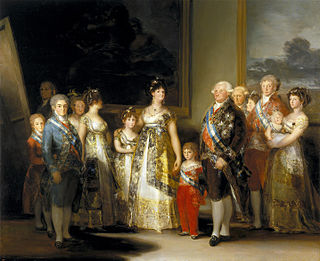
Charles IV of Spain and His Family is an oil-on-canvas group portrait painting by the Spanish artist Francisco Goya. He began work on the painting in 1800, shortly after he became First Chamber Painter to the royal family, and completed it in the summer of 1801.

The Colossus, is known in Spanish as El Coloso and also El Gigante, El Pánico and La Tormenta. It is a painting traditionally attributed to Francisco de Goya that shows a giant in the centre of the canvas walking towards the left hand side of the picture. Mountains obscure his legs up to his thighs and clouds surround his body; the giant appears to be adopting an aggressive posture as he is holding one of his fists up at shoulder height. A dark valley containing a crowd of people and herds of cattle fleeing in all directions occupies the lower third of the painting.
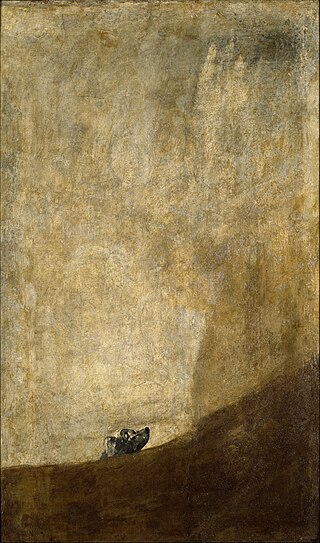
The Dog is the name usually given to a painting by Spanish artist Francisco de Goya, now in the Museo del Prado, Madrid. It shows the head of a dog gazing upwards. The dog itself is almost lost in the vastness of the rest of the image, which is empty except for a dark sloping area near the bottom of the picture: an unidentifiable mass which conceals the animal's body. The placard for The Dog painting in The Prado indicates the dog is in distress, quite literally, drowning.

Fight with Cudgels, called The Strangers or Cowherds in the inventories, is the name given to a painting by Spanish artist Francisco Goya, now in the Museo del Prado, Madrid. Goya did not give names to his Black Paintings. These names are courtesy of art historians. One of the series of Black Paintings Goya painted directly onto the walls of his house sometime between 1820 and 1823, it depicts two men fighting one another with cudgels, as they seem to be trapped knee-deep in a quagmire of mud or sand.
Witches' Sabbath or The Great He-Goat are names given to an oil mural by the Spanish artist Francisco Goya, completed sometime between 1821 and 1823. It explores themes of violence, intimidation, aging and death. Satan hulks, in the form of a goat, in moonlit silhouette over a coven of terrified witches. Goya was then around 75 years old, living alone and suffering from acute mental and physical distress.

La Leocadia or The Seductress are names given to a mural by the Spanish artist Francisco Goya, completed sometime between 1819–1823, as one of his series of 14 Black Paintings. It shows a woman commonly identified as Goya's maid, companion and lover, Leocadia Weiss. She is dressed in a dark, almost funeral maja dress, and leans against what is either a mantelpiece or burial mound, as she looks outward at the viewer with a sorrowful expression. Leocadia is one of the final of the Black Paintings, which he painted in his seventies at a time when he was consumed by political, physical and psychological turmoil, after he fled to the country from his position as court painter in Madrid.

Atropos, or The Fates is one of the 14 Black Paintings painted by Francisco de Goya between 1819–1823. Goya, then 75 and in mental and physical despair, created the series directly onto the interior walls of the house known as the Quinta del Sordo, purchased in 1819.

Judith and Holofernes is the name given to one of the 14 Black Paintings painted by Francisco de Goya between 1819 and 1823. By this time, Goya was in his mid 70s and deeply disillusioned. In mental and physical despair, he painted the private works on the interior walls of his home—applying oils directly on plaster—known as the Quinta del Sordo, which he had purchased in 1819. Judith and Holofernes was likely painted on the first floor, beside Saturn Devouring His Son. The picture is a personal reinterpretation of the narrative of the Book of Judith, in which the protagonist saves Israel from the assault of the general Holofernes by seducing and beheading him. Judith is the only historical figure who can be identified with certainty among the Black Paintings.

A Pilgrimage to San Isidro is one of the Black Paintings painted by Francisco de Goya between 1819–23 on the interior walls of the house known as Quinta del Sordo that he purchased in 1819. It probably occupied a wall on the first floor of the house, opposite The Great He-Goat.

Two Old Ones Eating Soup or Two Witches is one of the fourteen Black Paintings created by Francisco Goya between 1819 and 1823. By this time, Goya was in his mid-70s and deeply disillusioned. He painted the works on the interior walls of the house known as the Quinta del Sordo. They were not intended for public display. Two Old Men Eating Soup likely occupied a position above the main door to the house, between La Leocadia and Two Old Men.

Two Old Men, also known as Two Monks or An Old Man and a Monk, are names given to one of the 14 Black Paintings painted by Francisco Goya between 1819-23. At the time Goya was in his mid-seventies and was undergoing a great amount of physical and mental stress after two bouts of an unidentified illness. The works were rendered directly onto the interior walls of the house known as Quinta del Sordo, which Goya purchased in 1819.
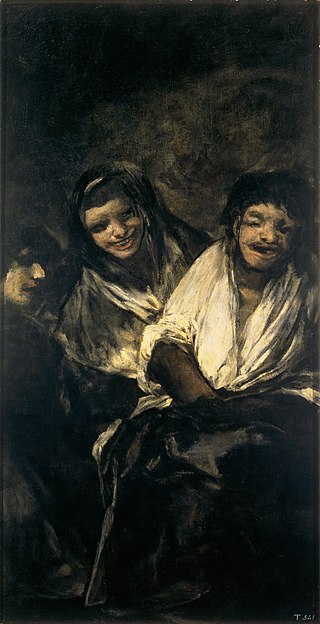
Man Mocked by Two Women or Women Laughing or or The Ministration are names given to a painting likely completed between 1820 and 1823 by the Spanish artist Francisco Goya.

Asmodea or Fantastic Vision are names given to a fresco painting likely completed between 1820 and 1823 by the Spanish artist Francisco Goya. It shows two flying figures hovering over a landscape dominated by a large tabled mountain. Asmodea is one of Goya's 14 Black Paintings—his last major series—which, in mental and physical despair, he painted at the end of his life directly onto the walls of his house, the Quinta del Sordo, outside Madrid.
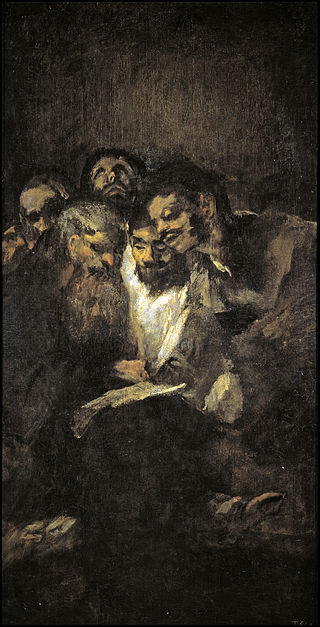
Men Reading or The Reading or Politicians are names given to a fresco painting likely completed between 1820 and 1823 by the Spanish artist Francisco Goya. It is one of Goya's 14 Black Paintings painted late in his life when, living alone in physical pain, spiritual torment and disillusionment with the political direction of Spain, he painted 14 bleak, agonised frescoes onto the walls of the Quinta del Sordo, the house he was living in alone outside Madrid.
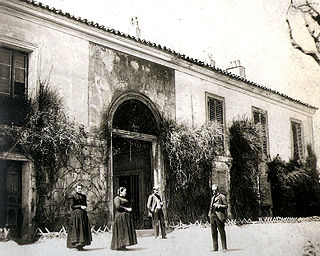
The Black Paintings is the name given to a group of 14 paintings by Francisco Goya from the later years of his life, likely between 1819 and 1823. They portray intense, haunting themes, reflective of both his fear of insanity and his bleak outlook on humanity. In 1819, at the age of 72, Goya moved into a two-story house outside Madrid that was called Quinta del Sordo. Although the house had been named after the previous owner, who was deaf, Goya too was nearly deaf at the time as a result of an unknown illness he had suffered when he was 46. The paintings originally were painted as murals on the walls of the house, later being "hacked off" the walls and attached to canvas by owner Baron Frédéric Émile d'Erlanger. They are now in the Museo del Prado in Madrid.

Salvador Martínez Cubells was a Spanish painter and art restorer, who specialized in history painting and Costumbrismo.

Quinta del Sordo, or Quinta de Goya, was an extensive estate and country house situated on a hill in the old municipality of Carabanchel on the outskirts of Madrid. The house is best known as the home of Francisco de Goya, where he painted 14 murals known as the Black Paintings. Contrary to popular belief, the estate was given its name due to the deafness of a prior owner, not Goya himself, who was deafened by illness in 1792. The house was demolished in 1909.
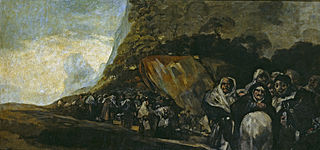
Pilgrimage to the Fountain of San Isidro or The Holy Office are names given to an oil mural by the Spanish artist Francisco Goya (1746–1828), probably completed between 1821 and 1823. The mural is one of the fourteen Black Paintings that Goya applied in oil on the plaster walls of his house. Between 1874 and 1878 the paintings were transferred to canvas supports under the direction of the art restorer of the Museo del Prado, Salvador Martinez Cubells.

Jean Laurent or, in Spanish, Juan Laurent Minier; sometimes simply J. Laurent was a French photographer who mostly worked in Spain.




















